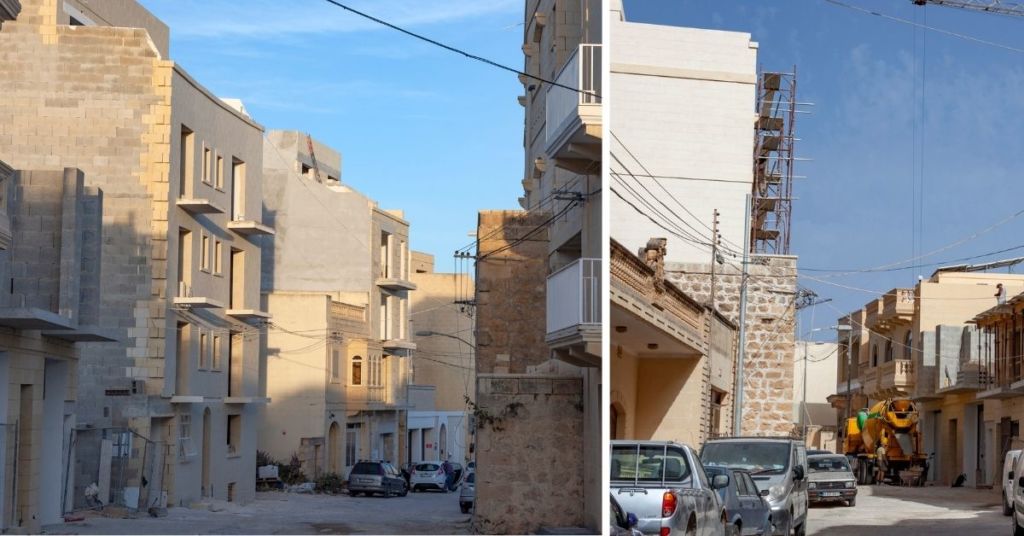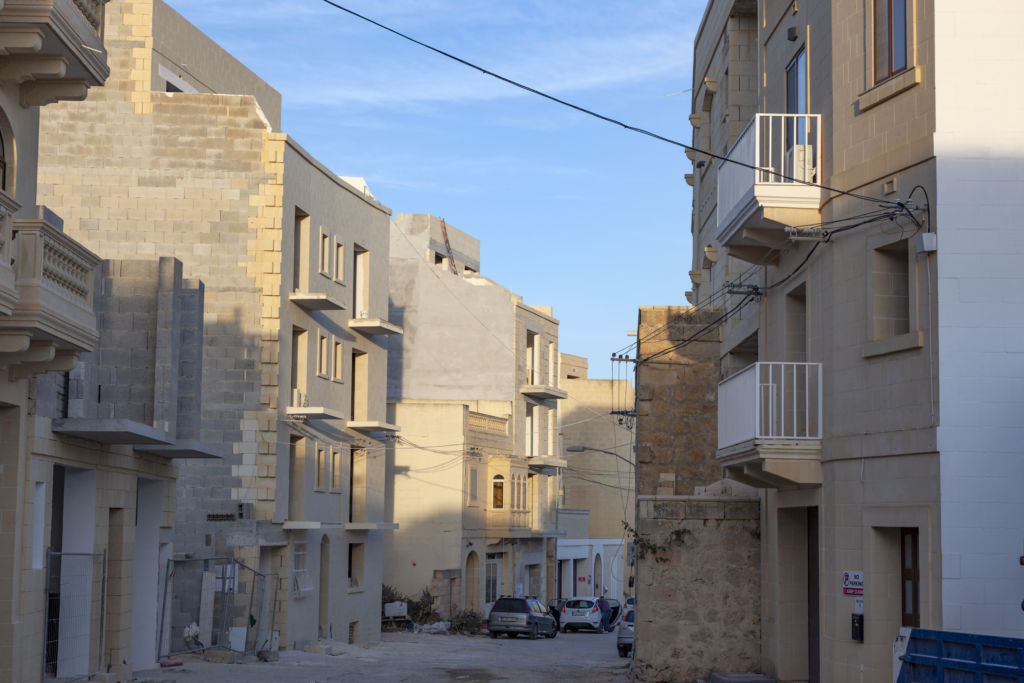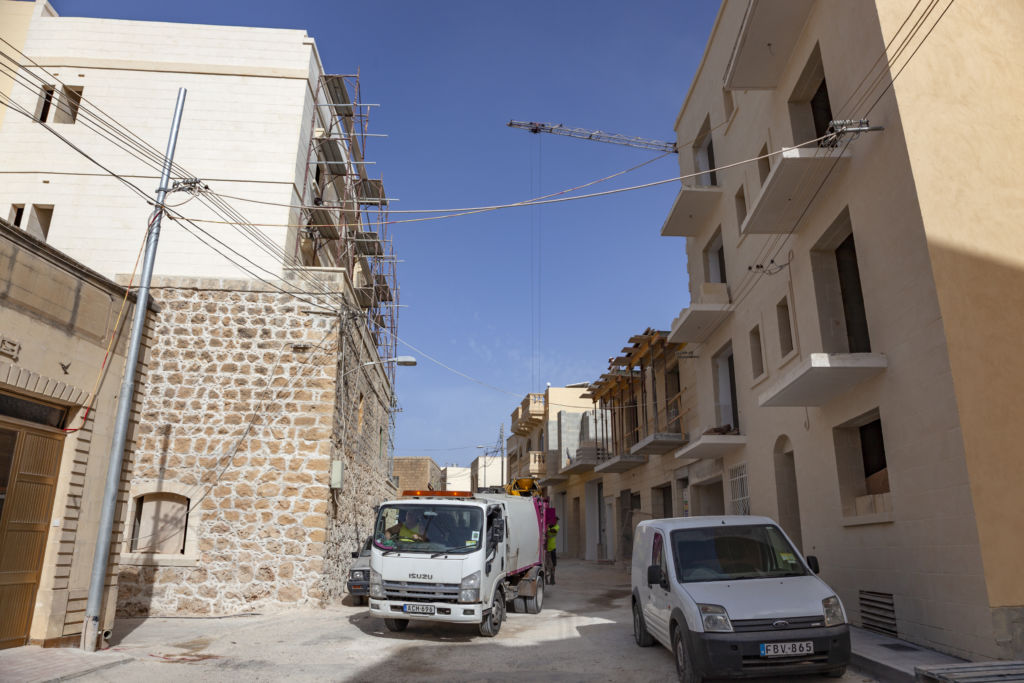A Street Disfigured In Gozo As Government Ignores Entreaties by All Gozitan Mayors

A 200-metre stretch of street in Xagħra called Ta Karkar would be an unremarkable backstreet if it were not for its radical transformation in the past two years, the kind of overdevelopment that has been decried by Gozo’s mayors, Chamber of Commerce, and Gozo Tourism Association as ruinous of Gozo’s character, landscapes, and way of life.
Two years ago Ta Karkar consisted of a scatter of two-storey houses and a very old farmhouse. Now a glut of eighty flats in twelve separate five-storey blocks by twelve separate applicants are arising, given a permit in 2019 and 2020 by the Planning Authority.
Most of the blocks have yet to rise, but the once-open, sunny street already feels hemmed-in and regimental, with the earlier townhouses interspersed among the blocks of flats like forlorn remnants.
And the farmhouse?
The Superintendence for Cultural Heritage had told the Planning Authority that it had “evident vernacular value” and that “any increase in height and volumes [of new additions to it] is to be in keeping with the context.” Yet the authority granted three permits in three stages over three years, with the end result being an outgrowth four-storey building subsuming the farmhouse.

The architect – Alex Bigeni, who is associated with various controversial developments in Gozo the past few years – denied that the fragmentary, three-stage approach was deliberate. Lovin Malta has published a separate article about the farmhouse.
The metamorphosis of Ta Karkar Street is far from unique. It’s a story repeated in countless streets in Gozo’s villages.
Statistics show that a quarter of all development applications pertain to Gozo, which has less than 10% of the national population. Many are for multistorey blocks of flats that have been invading neighbourhoods of two-storey townhouses, changing streetscapes and skylines, and changing the urban fabric from terraced townhouses with gardens to dense, nondescript flats that choke all greenery from within towns.
This is what compelled all of Gozo’s mayors, who coalesced under the auspices of Gozo’s Regional Council, to call for the scrapping of the policy framework that fostered this wave of development – a policy document adopted in 2015 known as DC15.
The policies introduced in DC15 allowed developers to cram five storeys within height limitation policies. According to Ruben Abela, a former manager at the planning authority, this policy change encouraged the development of flats – and redevelopment of townhouses into flats – over other types of dwellings.

In Gozo it led to a concurrent relative diminishment in the value of townhouses and farmhouses, which are only as valuable as the size of the land they sit on – or how many flats can be crammed in five-storeys in that given size of land.
This bonanza of flats, which are markedly cheaper than flats in Malta, fostered strong demand from Malta-residents seeking a holiday or weekend pad in Gozo.
“These blocks of flats are not only ruining the environment,” Samuel Azzopardi, president of the Gozo Regional Council, told Lovin Malta. “They are also affecting the quality of life given their density and low internal floors. It’s also an issue of light pollution, traffic congestion, sound pollution, strain on the infrastructure, and so on.”
He added: “I was walking my dog recently as it was getting dark, and I noticed lights streaming out of some of these new blocks of flats starting to change the character of Gozo of darkness descending over villages at night, punctuated only by streetlights. Can you imagine what it will be like in 10 years’ time?”

The mayors provided detailed proposals for reform of the planning system in Gozo, but there has been no feedback on their proposal from the Planning Authority or Environment Minister, whom they met 5 months ago.
A few weeks after meeting the mayors, Environment Minister Aaron Farrugia claimed on TVM that policies on heights could not be changed without risking claims for compensation from landowners, a claim that flies in the face of established law.
Planning Authority chairperson Martin Saliba also reportedly told The Times that you cannot just lope off two storeys from development-height policies in Gozo overnight – the mayors had called for permissible heights to be reduced. He added that the authority would instead pay more attention to the design of buildings in Gozo.
Aside from DC15, some of the developers at Ta Karkar also make use of another policy document adopted in 2015, called Rural Design and Guidance, which provided a policy framework for permitting swimming pools on land outside the development zone. It’s a policy that has been interpreted permissively by the Planning Authority, granting permits for such pools almost automatically.

Granting permits to such pools at Ta Karkar has in effect extended the development zone. Once again, this is not unique: development zones are being extended incrementally in this manner throughout Gozo.
The environmentalist Alan Deidun has in the past called the entire suit of such permissive policies introduced in 2015 as “death [of the countryside] by a thousand cuts.”
Various entities – ranging from NGOs to the Kamra tal-Periti (Chamber of Architects) – have denounced the Planning Authority’s failure to consider applications holistically and to ignore the cumulative impact of developments.
What do you think of the development?
